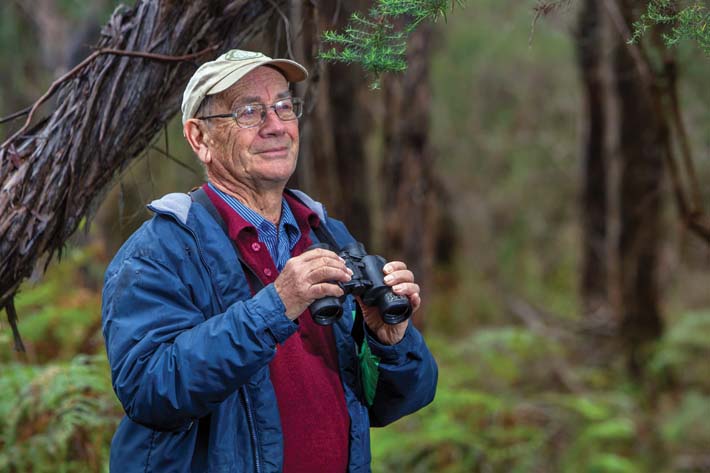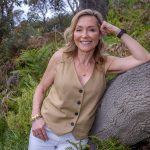
Max Burrows’ love of bird watching all started back at Brighton Primary School when a teacher introduced them to the Gold League of Bird Lovers.
“The kids all got a glossy certificate and we visited a bird sanctuary near Bacchus Marsh and I was sold,” said Max who has been a birder in his heart ever since. “I have done a lot of bird watching on the peninsula after living in the Frankston area for many years. I’ve seen new birds come into the area and birds leave when the habitat has changed. We have lost a couple of species over the years because development has wiped out a lot of bushland on the peninsula. A lot of birds only exist where there is specified bush land, but we have had other species come in like the little corella which is a white bird that is a species of cockatoo.”
As the president of Birdlife Mornington Peninsula, Max is an expert on bird species on the peninsula and is proud to say he has ticked off around 450 birds from his list.
“Most bird watchers would have a life list. When you see a bird for the first time you call it a lifer,” says the man who has spent around 50 years roaming Australia looking for birds. “I like the thrill of seeing new birds because there’s about 800 species of birds in Australia, although they keep finding new species of birds that might have accidentally come over here from Indonesia. For example we have just had a frigate bird which is a tropical bird that lives up in the coastal areas of Cape York and Darwin but this one was here and we think might have been blown down here by the big storms.”
Max explains that he is not a ‘twitcher’ however, although he is an avid bird watcher.
“Twitchers are a much more intense bird watcher who travel long distances to see a new species and add them to their life list. I have seen species from different areas but usually that’s just from being on holidays with the family,” he said. “Like most bird watchers you watch while taking holidays. In Western Australia there’s a bird called a splendid fairy wren which has a turquoise colour. I will never forget how it suddenly appeared and shone like a beacon that colour really stands out.”
Like most bird watchers, Max says once you start you are always on the lookout for a bird.
“I cannot go out the front of my house without seeing a magpie or other birds. Around the beaches you find birds like the hooded plover which is an endangered species that Birdlife Australia has launched a campaign for. You see the birds that nest on the beach, the gulls and the crested terns around the beaches, and the gannets in the actual water. We have so many different environments on the peninsula that attract different birds. The Briars and Coolart are similar as they have wetlands and forest. Coastal areas like Flinders beach attract overseas waders. These birds migrate to Russia and come over here in our summer and then go back to Siberia or Alaska. When summer is finished up there they come back to Australia again, with the same birds coming back to the same areas.”
While Birdlife Mornington Peninsula mainly attracts older members, Max says they like to encourage young people to see the benefits of birdwatching.
“We go to schools and do courses and figure this might be something the young people take up later in life. You get to walk in the bush which is a lovely thing to do, and there’s so many species in Australia. You just walk out on the street and you will see them,” said Max of this hobby that fosters patience, focus and attention to detail as well as awareness of environmental issues.
Not only does Max recognise many bird species by sight, he can also tell a bird by its call.
“It’s taken many years to hone my skills but now I know by the call what sort of bird it is before I see it. We have the Australian king parrots on the peninsula now, and yet early records show they weren’t here so they have arrived in the last 20 years and are reasonably common now. Some of these changes have to do with climate change; we have crested pigeons that weren’t here 20 years ago and we think the habitat is now suitable for their needs but it wasn’t before.”
Birdlife Mornington Peninsula has a strong following of about 300 members and assembles to look at conservation, education and encourage bird watching groups.
“It’s a worrying trend seeing more land being cleared and if we see something on the peninsula that is not right we react against it. We have been involved in issues with the Main Ridge flora and fauna reserve, and the Arthurs Seat quarry, keeping an eye on what is happening with the environment and how that will affect the birdlife.”
These days Max heads out with his binoculars and his life list, and occasionally his youngest daughter joins him.
“We head out for about three hours with the field guide which is a book with bird descriptions and where they might be found. Nowadays there’s also an app on the phone that gives you descriptions and the bird calls as well,” said Max. “We have an event called “What bird is that?”” on Sunday October 23. We invite the public to The Briars in Mt Martha and have a presentation on local birds, take people out on bird walks and have an information table for friends of the hooded plover as well as ourselves and other birdlife information as well.”
For more information on Birdlife Mornington Peninsula email Max at mornington@birdlife.org.au
Photos: Gary Sissons
FEATHERED FRIEND FACTS
All birds – from the huge common ostrich to the tiny bee hummingbird – are vertebrates, and all of them are included in the Aves scientific classification.
There are approximately 10,000 bird species today, more than all mammals and amphibians combined, and new bird species are discovered almost every year.
Birds are the only animals with feathers, and their feathers vary greatly in size, colour, shape and function. Birds rely on their feathers not only for appearance, but also for insulation, waterproofing, courtship displays and territorial defence.
The exact number of feathers any bird has depends on its species, age and gender, with young birds often having fewer, less specialised feathers. Adult birds may have from 1,500 to 25,000 feathers.
There are 57 different species of flightless birds, including ostriches, emus, kiwis and all penguins. These birds may not take to the air, but they all have wings. When birds don’t fly, their wings are used for different purposes, including courtship or threat displays, balance, steering or swimming.
Birds first appeared during the Mesozoic Era 150 million years ago, when they began to evolve from reptiles, including dinosaurs.
Birds have amazing senses, and their eyesight is the most amazing of all. On average a typical bird can see detail and motion two to three times better than any human. Birds can also distinguish colour subtleties better than humans, and a number of birds can see into the ultraviolet spectrum. Birds also have a larger field of view than humans.
Birds are well known for their songs, and a number of them are mimics. Depending on the species, they may be able to imitate not only the songs and calls of other birds, but also many other noises. Some birds even learn to mimic mechanical noises from construction sites, or may include phone ring tones, car alarm notes or video game sounds in their repertoire. Parrots are especially good mimics and can even imitate human speech.





